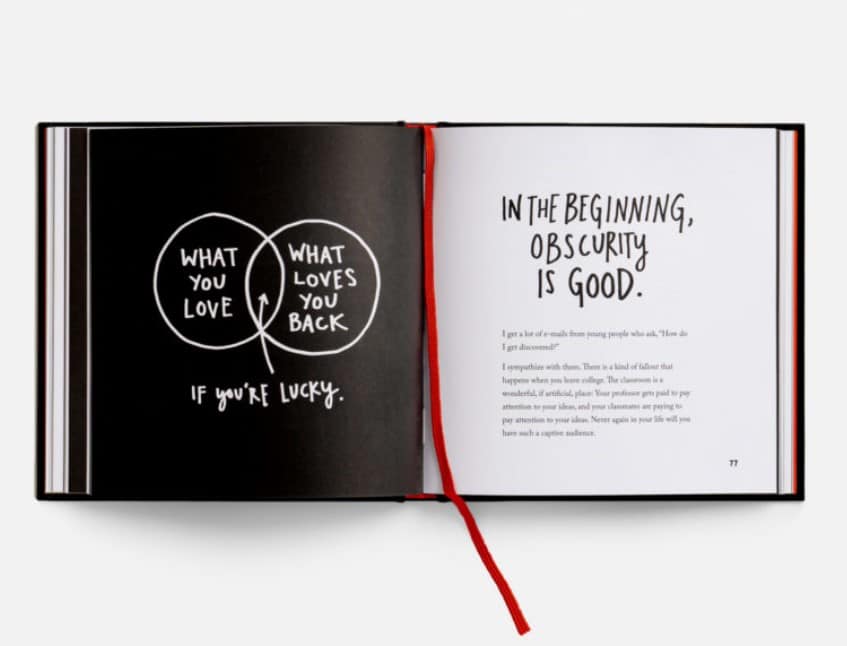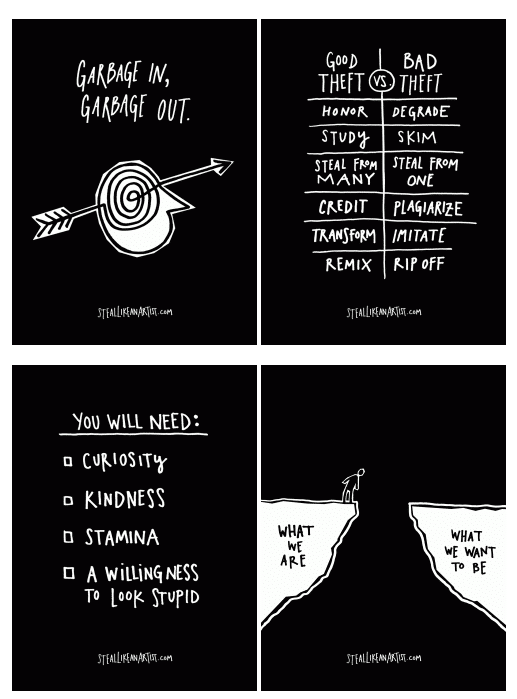|
Getting your Trinity Audio player ready...
|
Steal Like An Artist by Austin Kleon is a creative espresso shot for anyone looking to turbocharge their artistic mojo.
First hitting the shelves in 2012, this book has charmed everyone from painters and poets to tech moguls and college students.
Kleon’s main idea is both audacious and liberating: creativity isn’t about conjuring something out of thin air but rather about cleverly borrowing and remixing what’s already out there.
Today’s Steal Like an Artist book review dives into the book’s central themes, highlights its hits and misses, and evaluates its overall impact.
Read: The Artist’s Way: A Spiritual Path To Higher Creativity
Who is Austin Kleon?
Austin Kleon, the maestro behind Steal Like An Artist, isn’t just another author preaching from the ivory towers of artistic theory.
Nope, he’s a down-to-earth, scissors-in-hand, glue-stick-brandishing artist and writer who knows the creative trenches all too well.
Kleon, hailing from the heartland of creativity, has etched his name into the minds of aspiring creators with his refreshing takes on the creative process.
His work, a delightful cocktail of wit, wisdom, and real-world practicality, resonates with everyone from the struggling artist in a dimly lit studio to the corporate brainstormer in a glass tower.
This universal appeal has catapulted Kleon into being a beloved figure in circles where creativity is not just a buzzword but a way of life.
Overview of Steal Like An Artist
Steal Like An Artist isn’t just a book; it’s a manifesto for the creatively perplexed.
Austin Kleon strips down the mystique of the creative process and presents it in ten bite-sized, easily digestible principles.
At its core, the book challenges the conventional notion of originality, arguing that all creative work is, in essence, a remix of influences and inspirations.
It’s a liberating perspective that encourages embracing influences rather than running from them.
Kleon’s approach is refreshingly honest. He doesn’t sugarcoat the difficulties of creative work or overcomplicate it. Each of the ten chapters in Steal Like An Artist is a beacon, guiding the reader through the foggy realms of creativity.
Read: What is The Science Behind the Brain’s Creative Thinking
From ‘Nothing is original’ to ‘Be boring (it’s the only way to get work done),’ the ideas are not just about creating art but about cultivating a creative mindset that can apply to all aspects of life.
This book isn’t a step-by-step guide; it’s a lens through which to view your creative endeavors.
It challenges you to rethink what it means to be creative, urging you to steal from your inspirations and spin them into something uniquely yours.
Deep Dive into Key Ideas
Steal Like An Artist packs a punch with its ten transformative principles. Let’s unwrap some of these gems and see how they can revolutionize our creative process:
1. Nothing is Original
Austin Kleon begins his argument with the refreshingly provocative notion that originality is a myth. He contends that no piece of creative work is entirely original; rather, it is constructed upon the foundation laid by previous creators.
This concept challenges the traditional view of creativity as a solitary act of pure invention.
This revelation is a breath of fresh air, taking the pressure off trying to reinvent the wheel and instead encouraging us to embrace and transform our influences.
2. Don’t Wait Until You Know Who You Are to Get Started
Action breeds identity: Many wait for clarity about their creative identity before starting. Kleon suggests that this approach is backward.
Instead of waiting for clarity, he argues that we discover our true creative identity through the act of creation itself. By engaging in the process of making and doing, we uncover and develop our unique style and voice.
This proactive approach shifts the focus from introspection to action, encouraging individuals to dive into their work without the burden of preconceived notions about their identity.
Read: Top 10 Growth Ideas for Yourself at Work
According to Kleon, starting the creative process is the key to self-discovery. As we create, experiment, and iterate, patterns and preferences begin to emerge naturally.
3. Write the Book You Want to Read
Create what you love: This principle centers around the idea of passion-driven creativity. It emphasizes the importance of pursuing creative endeavors that resonate deeply with your personal interests and passions.
By focusing on what you genuinely love, you are more likely to produce work that is not only meaningful to you but also has the potential to connect deeply with others.
If you can’t find the book, song, or art you love, it’s your cue to create it. By creating what you love, you are naturally drawn to work that feels authentic and genuine.
This authenticity is often what sets great art apart, as it resonates on a deeper level with audiences. Passion-driven creativity also sustains long-term motivation and fulfillment.
4. Use Your Hands
In our pixel-dominated world, Kleon makes a compelling case for getting physical with your creative process. Drawing, writing by hand, and crafting tangible objects can spark innovative ideas by engaging different parts of your brain.
Drawing, for instance, is not just about producing an image but about the physical act of moving a pen across paper. This activity engages different parts of the brain compared to typing on a keyboard or tapping on a screen.
The tactile feedback, the resistance of the paper, and the motion of the hand all contribute to a unique sensory experience that can stimulate creativity in ways that digital tools may not.
Kleon’s emphasis on physical creation is a recurring theme throughout his book. He argues that in our increasingly digital lives, we risk losing touch with the physicality of creativity.
5. Side Projects and Hobbies Are Important
One of Kleon’s golden nuggets is the importance of having side hustles and hobbies. These aren’t just distractions—they’re secret weapons that can lead to unexpected breakthroughs.
By engaging in a variety of activities, you can stimulate different areas of your brain, foster creativity, and discover innovative solutions that might not emerge from focusing on a single project alone.
Read: Growth Ideas For Work
He advocates for a diverse portfolio of interests to keep the creative juices flowing. In addition to fostering creativity and innovation, having side hustles and hobbies can also contribute to your overall well-being and happiness.
6. The Secret: Do Good Work and Share It with People
Visibility is key: It’s not just about creating; it’s about sharing what you create. In today’s interconnected world, sharing your work is essential for a number of reasons.
It opens the door to feedback, opportunities, and connections that can significantly enhance your creative journey and career. Firstly, sharing your work allows you to receive valuable feedback.
When you put your creations out into the world, you invite others to engage with your ideas and offer their perspectives.
This feedback can be incredibly insightful, providing you with new ideas, identifying areas for improvement, and validating what works well.
Constructive criticism from peers, mentors, and even your audience can help you refine your craft and push the boundaries of your creativity.
7. Geography Is No Longer Our Master
Boundless creativity: With the internet, your audience and inspiration are global. Today, your audience is not confined to your local community or even your country; it spans the globe.
By sharing your work online, you can connect with people from different backgrounds who resonate with your ideas, offering broader and more varied feedback than ever before.
You can draw inspiration from a world of diverse ideas and cultures, connect with a global audience, and find your creative tribe beyond your immediate environment. Your creative tribe is out there beyond your physical confines.
8. Be Nice (The World is A Small Town)
Foster connections: Kleon underscores the importance of kindness and networking. Kleon advocates for kindness as a foundational principle in building a creative career.
This goes beyond mere politeness; it involves genuine respect, empathy, and support for others. Standing out through kindness can set you apart in a world where competition can be fierce.
Read: Quotes on Kindness
It creates a positive environment where people are more willing to share ideas, offer help, and engage in mutually beneficial collaborations. Being nice isn’t just ethical; it’s practical in the creative world.
9. Be Boring (It’s the Only Way to Get Work Done)
Forget the image of the chaotic, wild-eyed artist.
Kleon champions a methodical, disciplined approach to creativity.
By being “boring” with a solid routine and organization, you can create the stable environment needed to produce your best work.
When you have a solid routine in place, you free up mental energy that would otherwise be spent on figuring out what to do next. This allows you to focus entirely on the creative process itself.
10. Creativity is Subtraction
Less is more: In a world saturated with information, advertisements, and endless streams of content, the principle of “less is more” has never been more relevant. Austin Kleon emphasizes that choosing what to leave out is just as important as deciding what to include.
This concept is not only about simplicity but also about enhancing the impact and clarity of your work. By embracing constraints, you can actually foster greater creativity and innovation.
The principle of “less is more” also encourages mindfulness and intentionality in the creative process. It prompts you to ask critical questions about what is truly essential and what can be omitted.
Final Thoughts: Steal Like An Artist
Steal Like An Artist is a breath of fresh air in a world cluttered with clichéd self-help mantras. Its greatest strength lies in its simplicity and reliability.
LifeisPositive™ Rating ⭐️⭐️⭐️⭐️⭐️ (Is there a secret button for rating this beyond the standard five stars?)
I just fall in love with this book every time! Austin Kleon doesn’t just talk at you; he talks with you, sharing insights that feel like they’re coming from a wise friend.
The book’s brevity and punchy presentation (addictive) make it an easy yet impactful read, perfect for a quick creative pick-me-up. However, seasoned artists might find the content a bit basic.
While it’s a fantastic primer for beginners, those deep in their creative journey might crave more advanced techniques and deeper explorations.
Personally, the book was a reminder of the joy and playfulness of creating. It encouraged me to worry less about the pursuit of originality and more about the authenticity of my expression.
Steal Like An Artist rekindled my love for creation, reminding me that in the world of art, everything old can be new again. The book’s true magic lies in its ability to make us see connections between everything around us.
For anyone feeling stuck in their creative journey, Steal Like An Artist’s book is a reassuring hand on the shoulder, reminding us that all art is a beautiful patchwork of what has come before.
It’s a celebration of creativity, urging us to embrace our influences, to start where we are with what we have, and most importantly, to enjoy the process of making something uniquely ours.
For more empowering content, connect with our vibrant community here ➡️ Social Media.



